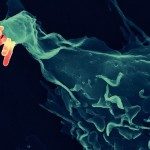Link to Pubmed [PMID] – 34044169
Link to DOI – 10.1016/j.jprot.2021.104276S1874-3919(21)00175-5
J Proteomics 2021 Jul; 244(): 104276
Mycobacterium tuberculosis, the etiological agent of tuberculosis, is among the deadliest human pathogens. One of M. tuberculosis’s pathogenic hallmarks is its ability to persist in a dormant state in the host. Thus, this pathogen has developed mechanisms to withstand stressful conditions found in the human host. Particularly, the Ser/Thr-protein kinase PknG has gained relevance since it regulates nitrogen metabolism and facilitates bacterial survival inside macrophages. Nevertheless, the molecular mechanisms underlying these effects are far from being elucidated. To further investigate these issues, we performed quantitative proteomic analyses of protein extracts from M. tuberculosis H37Rv and a mutant lacking pknG. We found that in the absence of PknG the mycobacterial proteome was remodeled since 5.7% of the proteins encoded by M. tuberculosis presented significant changes in its relative abundance compared with the wild-type. The main biological processes affected by pknG deletion were cell envelope components biosynthesis and response to hypoxia. Thirteen DosR-regulated proteins were underrepresented in the pknG deletion mutant, including Hrp-1, which was 12.5-fold decreased according to Parallel Reaction Monitoring experiments. Altogether, our results allow us to postulate that PknG regulation of bacterial adaptation to stress conditions might be an important mechanism underlying its reported effect on intracellular bacterial survival. SIGNIFICANCE: PknG is a Ser/Thr kinase from Mycobacterium tuberculosis with key roles in bacterial metabolism and bacterial survival within the host. However, at present the molecular mechanisms underlying these functions remain largely unknown. In this work, we evaluate the effect of pknG deletion on M. tuberculosis proteome using different approaches. Our results clearly show that the global proteome was remodeled in the absence of PknG and shed light on new molecular mechanism underlying PknG role. Altogether, this work contributes to a better understanding of the molecular bases of the adaptation of M. tuberculosis, one of the most deadly human pathogens, to its host.









